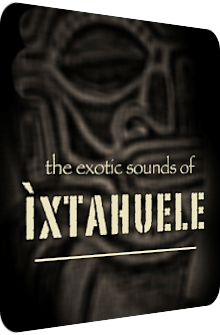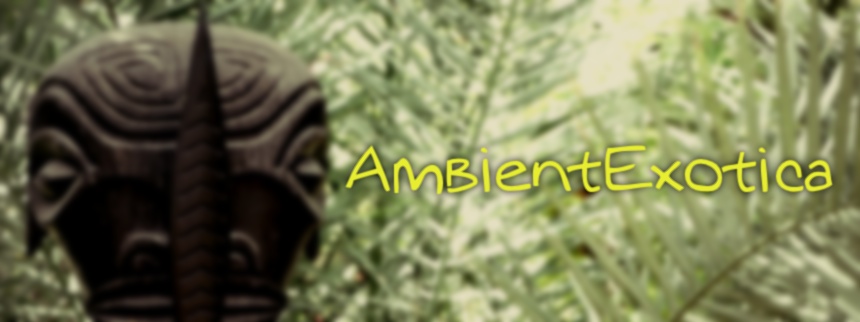
Ìxtahuele
The Exotic Sounds
Of Ixtahuele
2012
Fans of Exotica music are caught in a twofold time loop. Firstly, they come back to vintage material of the golden 50's and vibrant 60's time and again, bathing in waves of nostalgia, submerging into Hollywood strings and getting a good night's moonlight tan thanks to shimmering vibraphone glints. Secondly, this repetitive cycle is itself based on recycled material. How many versions of Misirlou/Miserlou, Taboo, Bali Ha'i and Caravan have they encountered once they fell prey to the vivacious dioramas the genre offers? It's this particular blend of already known material with new takes and interpretations that makes the genre so exciting to some and a tad boring for others. There's the occasional surprise, though: new material! Never heard before! Found on dusty reels behind a radiator! And then there's an even superior moment that outshines everything an Exotica fan could've wished for.
This moment has a name, a geographic location and five faces: Ìxtahuele from Sweden are the genre-related surprise of 2012 for me and one of the up-and-coming bands that will most definitely leave an everlasting impression. The band focuses on the halcyon days of Exotica and transports them unharmed and in sparkling quality to contemporary ears. But best of all is the fact that all of their compositions are unique, never heard before and tremendously melodious. This is neither third-stream music nor convoluted Jazz extravaganza. It's faux-Polynesian glamour with savage particles, tropical birdcalls and an iridescently gleeful nucleus.
The quintet consists of a whopping amount of three percussionists, and you hear their incessant impetus with every note: Johan Hjalmarsson is a dedicated percussionist, whereas both Mattias Uneback and Wictor Lind are also vibraphonists. While Carl Turesson Bernehed delivers either utterly catchy piano motifs or suave accentuations, bassist Henrik Nilsson is responsible for the belly-massaging vibrance of each tune. Talking about tunes: so far, the band has come up with four stellar compositions that can be heard in their entirety on Ìxtahuele's BandPage on Facebook. No proper release has been green-lit at time of writing, and believe me, this is an audacity of the gargantuan kind! Their material is so utterly dreamy, technicolored and at times even cinematic that I can only hope for further hits. In the meantime, let's check out the aforementioned four arrangements that are gathered on their showcase EP which is tentatively called The Exotic Sounds Of Ìxtahuele.
Majestic solemnity, that's what I'm thinking of when the lush thicket of the jungle fades and makes room for the extraordinarily balmy Gardens Of Mu. Launching with the increasing sustain of a gently droning temple gong-like instrument, the band immediately lets loose their catchy ten-note motif on polyphonous vibraphones, all the while glittering wind chimes, vivid birdcalls and rattling shakers provide the resplendent background that injects organic warmth and liveliness into the scenery right from the get-go. After this beatless introductory phase, carefully beaten bongos are splendidly accompanied by especially warm piano chords. The vibraphones shimmer in all colors and timbres: sometimes they're refreshingly gelid before the coalescence of their sustain boosts the dreaminess yet again. And those blazing cymbals and thunderous drum rolls! It's a terrific composition with not a single molecule of gloom in sight.
But there's one element that tops the whole arrangement while remaining perfectly embedded in-between the other instruments – the percussion. The bongos sound deliciously hollow and at times even a bit muffled. This quirky peculiarity is actually much appreciated and – maybe only temporarily – the signature sound of Ìxtahuele. Usually, percussive instruments become punchier, crunchier, more streamlined or even limewashed during sessions in professional sound studios. Luckily, this is not the case here, probably because of the lounge-like setting in which the takes were recorded. The reverb of the bongos paints the feeling of coziness and creates an actual room that is perpetually lost in high-budget studio records. The hollowness of these instruments remains one of the band's selling points and really augments the feeling of being in an original jungle setting or at a luau where a private gig is held. All in all, Gardens Of Mu is a gigantic hit, catchy to the max, and will please even overly critical fans of such iconic vibraphonists as Arthur Lyman, Cal Tjader or the quartet incarnation of Brian O'Neill's aka Mr. Ho's Orchestrotica.
Oh, right, there are three songs remaining on Ìxtahuele's tracklist, the next one being Xangri-lá Amongst The Mountain Tops. Starting off with the delicately croaking signature of Brazilian shakers and a four-note bongo base frame whose beats sound like liquid droplets, the vibraphones start playing shortly before the 30-second-mark. This time Ìxtahuele create a concoction of mystique and tranquility that is topped by an unexpectedly sunset-soaked whirr of warm piano backings and vibe glints. It's this permanent oscillation between enigmatic temple ruins as implied by the arcane frost of the vibraphone reverb, and opulently red-tinted mountain vistas thanks to the thermal heat of the euphonious piano tercets that drives and nurtures the experience.
The double bass backings sound remarkably like dark piano notes, so their resemblance expands the depth and deepness of this composition further. It's Bernehed's performance on the piano that makes this song another hit, and even though he isn't in the spotlight, he puts the right accents to the vibraphone melodies and increases the cinematic scope of this piece. Since there are no birdcalls featured on here, the feeling of towering above or being elevated onto the jungle is all the more apparent. Intensifying a perception through omission – that's something the band is able to achieve as well.
The first half of the EP is already a huge success, I'm running low of praising adjectives. The band doesn't care, as the guys change the style yet again, probably in the boldest possible way with Dengue Fever, a beast of a Latin bongo track which will appeal to followers of Don Ralke and Jack Costanzo alike. The gateway to this fever is realized with another four-note bongo motif that moves into an eclectic beat craze, but here the bongos are tribal, savage and threatening. Enough of the dreaminess, it's getting serious now, for I believe all percussionists, Hjalmarsson, Lind and Uneback, are at some point involved in creating this tropical groove… or better still: grove.
Glacial percussion, lamenting piano chords and marimba-esque vibraphones, the latter played in a staccato-martelato style, create a pitch-perfect savage hunt in a forlorn jungle. The song surprises in its second half with a megalomaniac bongo blitz chock-full of birdcalls, scattered piano chords and double bass accompaniments. The ensuing mélange of jumpy piano notes and hectic vibraphone foils rounds off this terrifically terrifying terror track which is ended on a mystifying note thanks to a Chinese gong whose sustain alone makes up about 1/5 of the song's whole duration! It's earned a place on my running playlist and can be perfectly linked to the hyperactive rendition of Voodoo Love by The Waitiki 7 or the car chase frenzy of Kono's Revenge by The Tikiyaki Orchestra.
The last and longest of Ìxtahuele's offerings is called Searching The Souq, an epic faux-Oriental piece of almost five minutes. The point of departure is yet dependent on the feeling of mystique, but whereas the previous flavors of this mood were erected via vibraphones, thus evoking a misty atmosphere of swirling veils, Searching The Souq places the gloomy vibraphone polyphony in-between the sizzling-hot, pernicious drones of pyramid vault-implying guitar strings that are strikingly similar to Middle Eastern instruments such as the sitar or the oud. The darkness is only slightly illuminated by pulsating wind chimes, clinging cymbals and placid bongos. It's the band's cinematic masterpiece.
This ambience is maintained for almost two minutes before the increasing volume of the lead bongos results in a more song-based structure where the vibraphones are played in clichéd but well-working Middle Eastern tone sequences, all the while the timbre of the piano counteracts in this regard and is much more friendly and warm-hearted, providing the much-needed source of luminescence on this track. The interplay between the vibe mystique and the piano warmth is presented once more before the EP ends with the entanglement of vibraphone sustain, piano sprinkles and the twinkling sound of a triangle.
There are those unexpected moments when I'm overwhelmed by the shimmering beauty and tropical glitz of Exotica music. And in this decade, these moods are delivered by more bands than ever, of which Ìxtahuele leave a ginormous impression. This is hand-made music that despises even the slightest scent of a synthesizer or Bachelor pad organ. Only The Waitiki 7 focused on this particular style before. Now we have a second Exotica band that does it, at least for the moment, for I wouldn't mind the inclusion of organs or electronic devices in Ìxtahuele's future releases at all! Luckily, both bands remain in different stylistic territories, so that the variety is maintained and each niche is filled in the best possible way.
If you like the melodious, intimate style of neo-Exotica without the orchestra string-heavy pompousness, Ìxtahuele deliver big, big time. At the moment, their hollow bongos are a huge selling point, and whether the band will get rid of this particular reverb or not is unforeseeable right now. But I do hope that this usually amateurish aura of cheap garage recordings is not perceived this way, as this kind of sound is seldom heard in the realms of Exotica. Whatever the band decides to make of it, these four tunes off their debut EP are twinkling gemstones in their current form, and as soon as they will be revved up in a proper studio, I'll compare them closely and find out whether their magic – or voodoo spell – still works on me. And to be honest, I very much look forward to this unspecified day.
I have no inside information, but I strongly believe that the band will come up with an official release very soon, whatever this may be. Yes, I'm running on empty in regard to my glowing appraisal. It's just that their EP is so utterly great that I cannot get my head around the notion that it hasn't been properly released as of yet. I wish Ìxtahuele all the best, and from now on, their music is with me all the time. All songs are recommended by me, and while each and everyone of them depicts a different setting or location, they merge very well and create a flow which is hard to resist. To use an oxymoron to describe their music: It's the best form of vintage neo-Exotica music you can get. The Exotic Sounds Of Ìxtahuele isn't a mere EP. It's an aural showcase brochure, a mind trip to Tropicando, or wait wait wait, now I got it: a Best-Of debut!
Exotica Review 099: Ixtahuele – The Exotic Sounds Of Ìxtahuele (2012). Originally published on Jul. 28, 2012 at AmbientExotica.com.
